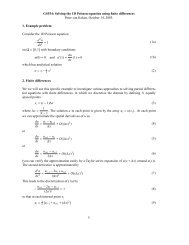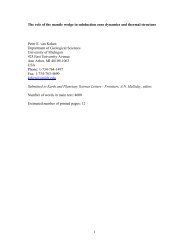Quantitative paleoenvironmental and paleoclimatic reconstruction ...
Quantitative paleoenvironmental and paleoclimatic reconstruction ...
Quantitative paleoenvironmental and paleoclimatic reconstruction ...
Create successful ePaper yourself
Turn your PDF publications into a flip-book with our unique Google optimized e-Paper software.
ARTICLE IN PRESS<br />
N.D. Sheldon, N.J. Tabor / Earth-Science Reviews xxx (2009) xxx–xxx<br />
37<br />
(hydrothermal) deposits, (2) delineate the paragenesis of mineralformation<br />
in soils <strong>and</strong> paleosols, (3) determine the extent of chemical<br />
weathering in soil <strong>and</strong> paleosol profiles, (4) determine variations in<br />
the composition of soil moisture δ 18 O <strong>and</strong> δD values, <strong>and</strong> (5) estimate<br />
the temperature of mineral crystallization.<br />
7.5.1. Origin of residual deposits<br />
In their study of economic copper deposits, Sheppard et al. (1969)<br />
analyzed δ 18 O <strong>and</strong> δD values of phyllosilicates from the Idaho batholith.<br />
These workers arbitrarily selected an isotherm near 40 °C that<br />
represents equilibrium with meteoric water in order to separate<br />
minerals that formed by hypogene (δ 18 O <strong>and</strong> δD values that correspond<br />
to N40 °C) processes from minerals that formed by supergene<br />
(δ 18 O <strong>and</strong> δD values that correspond to b40 °C) processes (Fig. 21).<br />
This supergene/hypogene reference isotherm continues to be used<br />
with all sorts of hydroxylated minerals in order to differentiate lowtemperature,<br />
from high-temperature, weathering deposits (Sheppard<br />
<strong>and</strong> Taylor, 1974; Sheppard <strong>and</strong> Gustafson, 1976; Hassanipak <strong>and</strong><br />
Eslinger, 1985; Marumo, 1989; Cravero <strong>and</strong> Dominguez, 1992; Cravero<br />
et al., 1991, 2001; Yiu <strong>and</strong> Chang, 1999; Matthews et al., 1999; Tabor<br />
et al., 2004a,b). Fig. 21 shows the supergene/hypogene line for<br />
kaolinite. Also shown are previously reported δ 18 O <strong>and</strong> δD values of<br />
kaolinite from hydrothermal, diagenetic <strong>and</strong> pedogenic weathering<br />
environments (see figure caption for appropriate citations). The range<br />
of kaolinite δ 18 O <strong>and</strong> δD values indicates that many of the world's<br />
kaolinite deposits are likely derived from low-temperature, supergene<br />
weathering (e.g., Hassanipak <strong>and</strong> Eslinger, 1985; Bird <strong>and</strong> Chivas, 1989,<br />
1993, 1995; Cravero et al., 1991; Lawrence <strong>and</strong> Rashkes Meaux, 1993;<br />
Mizota <strong>and</strong> Longstaffe, 1996; Delgado <strong>and</strong> Reyes, 1996; Harris et al.,<br />
2000; Matthews et al., 1999; Boulvais et al., 2000; Fig. 21).<br />
In consideration of the possible origin(s) for goethite δD <strong>and</strong> δ 18 O<br />
values, Yapp (1993a, 2001a,b) further refined the meaning of supergene<br />
processes with the concept of surface domains in order to differentiate<br />
goethite samples that formed by earth-surface processes<br />
from goethites that formed by higher-temperature processes. This<br />
concept was subsequently exp<strong>and</strong>ed to surface domain arrays for<br />
kaolinite (Savin <strong>and</strong> Hsieh, 1998), smectite (Tabor <strong>and</strong> Montañez,<br />
2005) <strong>and</strong> complex mixtures of kaolinite <strong>and</strong> 2:1 phyllosilicates<br />
(Tabor <strong>and</strong> Montañez, 2005). While it is difficult, <strong>and</strong> probably impossible,<br />
to demonstrate with absolute certainty that a hydroxylated<br />
mineral formed within a soil (<strong>and</strong> remained unaltered within the<br />
paleosol) profile, surface domains are constrained by a global dataset<br />
of mean annual rainfall δ 18 O <strong>and</strong> surface air temperatures, <strong>and</strong> thus<br />
provide a quantitative means to assess whether a mineral's δ 18 O <strong>and</strong><br />
δD values are consistent with environmental conditions that are<br />
expected during pedogenesis.<br />
Specifically, the modern surface domain uses the weighted mean<br />
δ 18 O value of precipitation (δ 18 O precip ) from each site in the IAEA<br />
database in order to calculate the corresponding δD of meteoric<br />
precipitation (Rozanski et al., 1993). This assumes that the meteoric<br />
water line (MWL) of Craig (1961) correctly represents the relationship<br />
between the δD <strong>and</strong> δ 18 O of meteoric waters through time. In addition,<br />
only waters from IAEA sites with a mean annual temperature N0 °C are<br />
used to construct the MSD, as it is expected that liquid water is a<br />
requirement for crystallization of hydroxylated minerals. This treatment<br />
of the IAEA database yields 184 data points, ranging from 0 °C to<br />
~30 °C (Fig. 15). When considering these modern IAEA data in<br />
conjunction with oxygen <strong>and</strong> hydrogen isotope fractionation factors<br />
for a given mineralogy, there is a resulting array of estimated mineral<br />
δD <strong>and</strong> δ 18 O values that define a MSD. Fig. 21 shows the calculated<br />
MSD for kaolinite. Also shown are published kaolinite δD <strong>and</strong> δ 18 O<br />
values (see Fig. 21 caption for references). Of the 79 different kaolinite<br />
samples taken from soil <strong>and</strong> paleosol profiles, 75 samples reside within<br />
the MSD (data points labeled “pedogenic” in Fig. 20).<br />
The Warm Earth Surface Domain (WESD) model assumes global<br />
temperatures 5 °C warmer-than modern, <strong>and</strong> no significant continental<br />
ice sheets (Yapp, 2001a,b). This concept of the WESD array<br />
may be appropriate for “greenhouse world” intervals (Early Paleozoic,<br />
most of the Mesozoic, Early Cenozoic; e.g., Frakes et al., 1992).<br />
Using kaolinite as an example, the resultant WESD is plotted along<br />
with the MSD (Fig. 21). The WESD is somewhat more inclusive of<br />
kaolinite samples with lower δ 18 O <strong>and</strong> δD compositions than its<br />
corresponding MSD. All but one of the 4 pedogenic kaolinites that<br />
reside outside the MSD in Fig. 21 fall within the limits of the WESD.<br />
Therefore, ~99% of paleosol kaolinite sample δ 18 O <strong>and</strong> δD values can<br />
be adequately explained within the contexts of the MSD <strong>and</strong> WESD,<br />
<strong>and</strong> thus may provide some insights to low-temperature earthsurface<br />
processes. δ 18 O <strong>and</strong> δD values of samples that fall outside of<br />
the surface domain arrays must be explained by other processes,<br />
such as a non-pedogenic origin, or diagenetic alteration of pedogenic<br />
minerals.<br />
7.5.2. Variations in soil moisture δ 18 O <strong>and</strong> δD values<br />
Numerous studies have demonstrated that δ 18 O <strong>and</strong> δD values of<br />
hydroxylated soil minerals reflect the isotope composition of soil water<br />
(Savin <strong>and</strong> Epstein, 1970a; Lawrence <strong>and</strong> Taylor, 1971, 1972; Yapp,<br />
1993a, 2001a,b; 2002; Hsieh, 1997; Vitali et al., 2000, 2001).<br />
Hydroxylated soil minerals form by (1) transformation of pre-existing<br />
framework minerals in the soil by rapidly downward percolating soil<br />
waters (Beauvais <strong>and</strong> Tardy, 1991; Wilson, 1999; Bird et al., 1994b) or<br />
(2) direct precipitation from soil solutions with high Si, Al <strong>and</strong> Fe<br />
activities in poorly drained parts of soil profiles (Keller,1963; Bourange<br />
et al., 1975; Wilson, 1999). As a result, soil waters that react to form<br />
hydroxylated soil minerals tend to have δ 18 O <strong>and</strong> δD values which very<br />
closely reflect regional meteoric precipitation (Bird et al., 1992, 1994b;<br />
Giral-Kacmarcík et al., 1998). While the resulting δ 18 O <strong>and</strong> δD values of<br />
the hydroxylated minerals may be offset from the true δ 18 O <strong>and</strong> δD<br />
values of meteoric precipitation due to isotope fractionation (see<br />
Table 5), numerous studies have used the δ 18 O <strong>and</strong> δD values of soil <strong>and</strong><br />
paleosol hydroxylated minerals as temporal <strong>and</strong> spatial proxies for<br />
relative changes in the oxygen <strong>and</strong> hydrogen isotope composition of<br />
soil moisture <strong>and</strong> meteoric precipitation.<br />
Lawrence <strong>and</strong> Taylor (1972) initially demonstrated that δ 18 O<br />
<strong>and</strong> δD values of pedogenic phyllosilicate, gibbsite <strong>and</strong> amorphous<br />
aluminosilicates track regional meteoric precipitation δ 18 O <strong>and</strong> δD<br />
values. Dutta <strong>and</strong> Suttner (1986) noted that δ 18 O values of early<br />
diagenetic-silicate cements (kaolinite, smectite, <strong>and</strong> quartz) from<br />
arkosic s<strong>and</strong>stones of the Gondwana Supergroup in India become<br />
more positive in younger strata, a pattern which they attributed to<br />
northward migration of the subcontinent through warmer climates<br />
characterized by more positive meteoric water δ 18 O values (e.g., see<br />
global rainfall δ 18 O values in Fig. 15).<br />
Bird <strong>and</strong> Chivas (1988a,b, 1989, 1993; Chivas <strong>and</strong> Bird, 1995; See<br />
also Botz et al., 1986) focused upon kaolinite δ 18 O <strong>and</strong> δD values from<br />
Upper Paleozoic through Neogene strata of the Australian regolith.<br />
Australian kaolinites record more positive δ 18 O values through time,<br />
from ~+6‰ in Permian strata to +18‰ in Miocene strata, which was<br />
also attributed to northward tectonic drift of the Australian continent.<br />
Collectively, these studies demonstrate the utility of hydroxylated<br />
soil-formed minerals as monitors of long-term (10 6 –10 8 yr) climatic<br />
change on the time-scales of tectonic processes. Bird <strong>and</strong> Chivas<br />
(1988b) also noted that Paleozoic <strong>and</strong> Lower Mesozoic kaolinites<br />
appear to have δD values that are too positive for pedogenesis (see<br />
black squares in Fig. 21). They interpreted these results to indicate that<br />
kaolinite samples have retained their Paleozoic <strong>and</strong> Mesozoic<br />
pedogenic δ 18 O values, but that these samples also have undergone<br />
post-formational (i.e., diagenetic) exchange of hydrogen isotopes,<br />
which has resulted in δD values that appear too positive for crystallization<br />
with meteoric water at soil temperatures (Fig. 21). Note<br />
that most of these suspect kaolinite samples have δ 18 O values that are<br />
too negative for either the modern surface domain (MSD) or warm<br />
earth suface domain (WESD; Fig. 21). In this regard, post-formational<br />
Please cite this article as: Sheldon, N.D., Tabor, N.J., <strong>Quantitative</strong> <strong>paleoenvironmental</strong> <strong>and</strong> <strong>paleoclimatic</strong> <strong>reconstruction</strong> using paleosols, Earth-<br />
Science Reviews (2009), doi:10.1016/j.earscirev.2009.03.004















